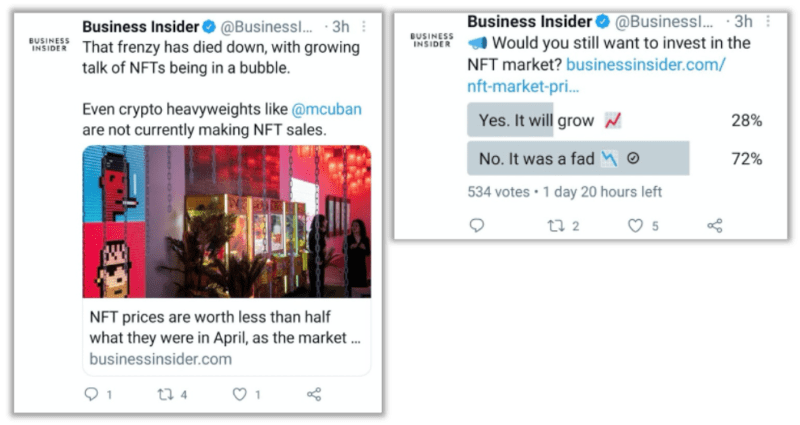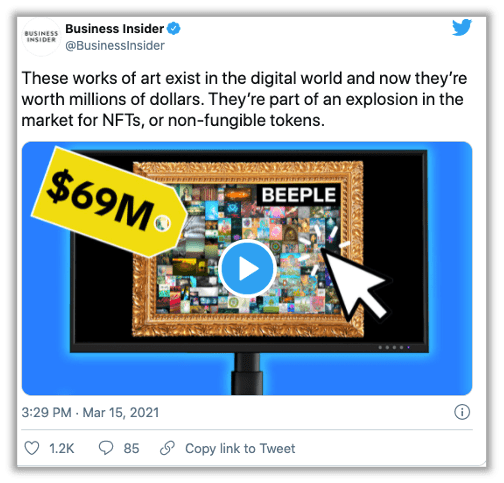NFTs and the continued quest for content monetization
News broke in March of this year that an NFT by the well-known digital artist Beeple, aka Mike Winklemann, sold at Christie’s for $69 million. Yes, sixty-nine million dollars.
While more than a few people were left scratching their heads about NFTs, content creators, artists and brands alike started asking good questions about what this means for the future of the content monetization landscape.
Some are doing more than asking good questions. Broadcast animation powerhouse Fox announced a new animated comedy Krapopolis at this year’s upfronts and is quickly making a name as a media leader in the space. The Verge reported from the upfronts that this new animated comedy is curated entirely on blockchain and is aligned with its own NFT company, Blockchain Creative Labs.
What the hell’s an NFT?
If you’re one of those left scratching your head, there’s plenty now written about NFTs. However, our collective favorite is this Saturday Night Live sketch featuring performers Pete Davidson and Chris Redd as they’re joined by rapper Jack Harlow to explain – far better than we could.
Shout out to our friends at NBCUniversal and Peacock where you can stream now.
Thanks to Jack Harlow, we have a very concise description of NFTs. “Here’s the thing about NFTs. It’s a non-fungible token you see. Non-fungible means that it’s unique. There can only be one like you and me. NFTs are insane. Built on a blockchain. A digital ledger of transactions. It records information on what’s happening. When it’s minted, you can sell it as art,” he raps. According to Forbes, “an NFT is created, or “minted” from digital objects.” They can range from art and music to GIFs, videos and sports highlights, virtual avatars, and more.
NFTs are often likened to trading cards which have – like everything – gone digital. The Hollywood Reporter says the dedicated Krapopolis marketplace will sell items like this and more to serve future fans.
The great dispersion
What’s happening with NFTs is simply a continuation of the desire anyone and everyone to better monetize content. It shouldn’t come as a surprise given we’re seeing the entire media landscape as we know it being re-written. TV[R]EV thoughtfully broke down the Discovery-Warner deal while Variety recently covered Amazon’s $9 billion offer for MGM. (Both face mounting antitrust concerns in Washington, but in many minds, the consolidation has already happened.)
To look at content monetization from an artist’s perspective, let’s take the music industry. Much has been written about musicians and conflicts over streaming revenues, particularly during the pandemic with tours grinded to a halt. Best-selling author, NYU professor and podcaster Scott Galloway tackles NFTs and blockchain in his May 17 episode.
Armed by Statista and other data, Galloway hypothesizes of a great dispersion. Blockchain offers artists more direct revenue sources, and this will displace the existing supply chain, he says. The middlemen who extract value and “starch all of the margin from it” are often disparaged by the artists themselves. Though Galloway recognizes it’s fair to argue the system isn’t broken given people still continue to create and post content to platforms, it’s the monopolies he says that allows them to extract rents that should ultimately go to creators.
That helps explain why long-established artists like Eminem (nod to the parody from SNL above), are joining those of the next generation like The Weeknd in expanding their own revenue streams through NFTs.
As for media entities, the play is likely to be one more of fan engagement and marketing. Krapopolis’ marketplace will “curate and sell digital goods ranging from NFTs of one-of-a-kind character and background art and GIFs, as well as tokens that provide exclusive social experiences to engage and reward super fans,” according to Fox.
What’s the downside?
The Beeple event being extreme, it’s certainly not the only NFT sale to garner major attention. From Jack Dorsey’s first-ever tweet to NBA Top Shots, NFT sales are proving there is a market. Remember ‘disaster girl?’ Now a college senior, her famous image was sold at auction for nearly $500,000 in April.
But it’s not all upside as illustrated by the tweets below from Business Insider. These were captured on May 18, 2021, following a tremendous amount of activity in the space.

We still have a lot to learn about this nascent space, especially given NFTs are typically bought and sold using cryptocurrency, which could be argued is still a nascent market itself. There’s also a growing ecological debate around the sustainability of crypto and the minting of NFTs. So, there are risks.
However, as we’ve learned in streaming and throughout the history of business, to the first movers go the biggest advantages.
Brands and media take heed
“I never thought I could sell my work like this,” says Mike Winklemann.

While it’s certainly an attractive new avenue of monetization for artists and creatives, some may be questioning how can brands get in the game – and should they? While it’s yet to be determined if NFTs are a blip in the journey of content monetization or if they’ll have lasting staying power, we could see a few ways this could play out for brands and individuals.
Amanda Gorman, the 23-year-old youth poet laureate and standout star of President Biden’s inauguration, signed with IMG Models shortly after the event and landed a Vogue magazine cover. Could Gorman’s interest in and foray into fashion lead to a collaboration with a major fashion label to release a limited edition NFT of an original poem written by her?
Or could entertainment venues develop an NFT strategy as a reentry point to recoup after Covid-canceled live events? Will we see an increase from celebrities or people of note like Kim Kardashian or Dr. Anthony Fauci who seek individual ownership of their own content, even down to tweets?
It’s too soon to tell what the future holds for NFTs, but this form of content monetization is likely not going away. If you’re a media entity, that doesn’t mean you have to commit at the same level as Fox. For brands and media entities alike, the best course likely means a path toward rapid discovery, understanding, testing and innovation centered upon your brand and consumer segments.
Content contributors: Beth Miller, Mike Salmon, Tiffany Vasilchik and Jen Joly
